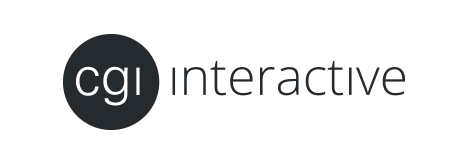
Whether you’re interested in improving your skills or staying ahead in business, we all need a way to hack the learning process — something that jump-starts our knowledge, so we can balance the need to know against our daily obligations. At CGI Interactive, we find that peer to peer learning fills that need. It’s so effective that we take the time to have knowledge-sharing sessions.
Recently, Art Director Sue Serra and Sr. Visual Designer Chris Burbank attended a Design Thinking workshop where they learned how to approach the process of understanding end-user experiences to generate creative solutions effectively. Then, they organized a peer to peer learning session for the rest of the CGI team. I thought it would be helpful for others to hear their thoughts. Enjoy!

Chris Burbank
Peer to peer learning is an engaging way to simultaneously teach and learn about a broad range of topics that can help energize your staff and open up new opportunities. Peer to peer learning comes in two flavors:
- The knowledge sharers are already experts on a specific topic and are teaching their peers based on their own experiences
- Or they have taken a course or attended a lecture and are disseminating what they’ve learned, tailoring it to the broader group
Sue Serra
We find it’s a very effective method of fast knowledge transfer.
Sue Serra
A short-cut to learning. Our staff understands their challenges and our agency’s processes better than any outside training or consultant could. That level of insight is valuable when it comes to fostering a useful learning environment. For this reason, we adjusted our exercises to align with our internal processes. This engaged participants immediately and created a short-cut to learning.
A common language. Peers already know how to best communicate with those in their group. And let’s face it, creatives have a specific language when it comes to the visual design process. Starting at this level allowed us to remove the burden of figuring out how ‘this’ relates to me and how I work.
Chris Burbank
A tailored class structure. We worked collaboratively to teach a hands-on, analog class — that’s right, NO technology — to help our peers think outside of the box. It was a way to shake-up their usual design thinking and how it maps to a process. For the class structure, we used three steps:
- Timed segments helped corral the creative process and set parameters. Being creatives, Sue and I understand that structure and creativity pair well, especially when teaching a group.
- The interview-style format for the partner pairings meant everyone had a dialogue and quality interactions that promoted listening. Additionally, we brought it back to the basics with pen and paper for note-taking, which according to the ASCD, is a useful memory and learning aid because it prompts you to think about what you’re learning.
- Prototypes: For the last step in our peer to peer learning exercise, we prototyped a physical solution from the problem that each person discovered from their partner during the interview phase. The prototyping segment was hands-on and fun. Taking it back-to-basics, we used craft supplies such as pipe cleaners, cotton balls, plates, paper, you name it! The array of tangibles helped everyone bring their solutions to life.

“The interview format helped us jump-start the conversation and quickly get to the heart of the topic, while the team-up between our staff brought new insights regarding the people we work with every day.”
Shayla, Project Manager
“Much like our clients, each member of the CGI team creates, communicates, and collaborates in their own (often impressive!) way. Ultimately, learning to listen to one another can be far more conducive to a successful campaign than simply executing a good idea.”
Nick, Motion Designer
“I can see applying the thought processes involving the interview discussion during my workday. It will be an essential skill when asking our clients the right questions to get to their core needs and solve their concerns in a simple manner.”
Chau, Visual Designer
Sue Serra
It’s not just the learners that have advantages in peer to peer learning; teaching is one of the best ways to learn. Teachers not only reinforce their understanding but also gain insights from how others perceive the same content. By putting our course together, we were able to grasp a deep understanding of the material.
Chris Burbank
Teaching is an excellent way to see how well you know your stuff. At first, it was challenging to distill everything into easily digestible content, but collaborating made it easy because both Sue and I had a different way of thinking about the material, which helped us come to a suitable format quickly. Ultimately, what I learned was that you gain a deeper understanding of a topic when you have to teach it to others. Then you can adjust parts of the content or process to perfect it the next time you teach. It’s one thing to know something, and it’s another thing to be able to articulate and deliver your knowledge in a meaningful way.

